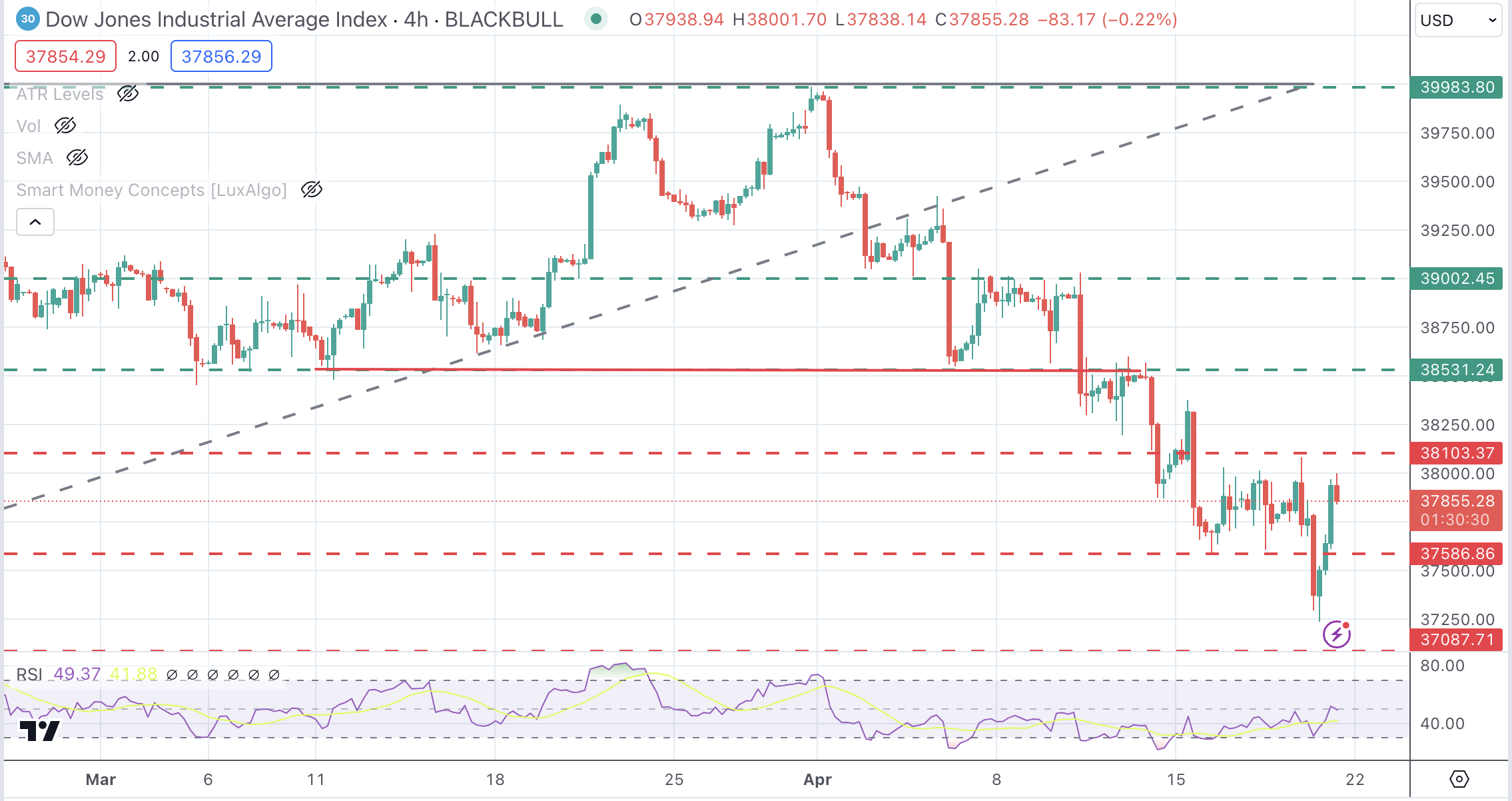Dow Jones advances fuelled by American Express quarterly earnings
- Dow Jones gains on the back of bright earnings data from American Express.
- Geopolitical concerns have eased, but investors remain wary of risk.
- Dow Jones trend needs to break resistances at 38,105 and 38,531 to cancel the bearish bias.
The Dow Jones Industrial Average (DJIA) is trading moderately higher on Friday with Wall Street indexes mixed on looming geopolitical concerns. American Express has shown better-than-expected revenue, net income, and EPS numbers boosting its yearly growth prospects and pushing the whole index higher
News from an Israeli attack on Iran rattled markets earlier on Friday, although the Islamic Republic has downplayed the incident and showed no intention to retaliate.
The US economic calendar is light today. Chicago Federal Reserve President Austan Goolsbee reiterated the lack of progress on inflation but showed confidence that core inflation will return to the 2% level.
The Dow Jones irises 0.6% to 38,007, while the S&P 500 drops 0.45% to 4,987 and the NASDAQ dives 1.38% to 15,386.
Dow Jones news
A majority of the Wall Street sectors are posting gains with Energy stocks leading gains thanks to a 1.2% advance, followed by Utilities, up 1.2%. On the negative side, Communication Services drops 1.6%, and Technology is down 1.4%.
American Express (AXP) rallies 5.5% to $229.37. Next is United Health Group (UNH) with a 2.7% gain to $506.21. On the losing end, Amazon (AMZN) drops 2.1% to $175.47, and Apple (AAPL) loses 1.1% to $165,06.
Dow Jones technical outlook
The DJIA is trimming some losses on Friday, although the broader bearish trend from March highs near 40,000 remains intact. The resistance area at 38,103 should be breached to ease downside pressure and clear the path toward 38,530.
On the downside, the support level at 37,087 is the 38.2% Fibonacci retracement of the November-March rally and a previous support area. This might be a tough nut to crack for sellers. Below here, the target is 36,545.
Dow Jones Index 4-Hour Chart

Dow Jones FAQs
The Dow Jones Industrial Average, one of the oldest stock market indices in the world, is compiled of the 30 most traded stocks in the US. The index is price-weighted rather than weighted by capitalization. It is calculated by summing the prices of the constituent stocks and dividing them by a factor, currently 0.152. The index was founded by Charles Dow, who also founded the Wall Street Journal. In later years it has been criticized for not being broadly representative enough because it only tracks 30 conglomerates, unlike broader indices such as the S&P 500.
Many different factors drive the Dow Jones Industrial Average (DJIA). The aggregate performance of the component companies revealed in quarterly company earnings reports is the main one. US and global macroeconomic data also contributes as it impacts on investor sentiment. The level of interest rates, set by the Federal Reserve (Fed), also influences the DJIA as it affects the cost of credit, on which many corporations are heavily reliant. Therefore, inflation can be a major driver as well as other metrics which impact the Fed decisions.
Dow Theory is a method for identifying the primary trend of the stock market developed by Charles Dow. A key step is to compare the direction of the Dow Jones Industrial Average (DJIA) and the Dow Jones Transportation Average (DJTA) and only follow trends where both are moving in the same direction. Volume is a confirmatory criteria. The theory uses elements of peak and trough analysis. Dow’s theory posits three trend phases: accumulation, when smart money starts buying or selling; public participation, when the wider public joins in; and distribution, when the smart money exits.
There are a number of ways to trade the DJIA. One is to use ETFs which allow investors to trade the DJIA as a single security, rather than having to buy shares in all 30 constituent companies. A leading example is the SPDR Dow Jones Industrial Average ETF (DIA). DJIA futures contracts enable traders to speculate on the future value of the index and Options provide the right, but not the obligation, to buy or sell the index at a predetermined price in the future. Mutual funds enable investors to buy a share of a diversified portfolio of DJIA stocks thus providing exposure to the overall index.